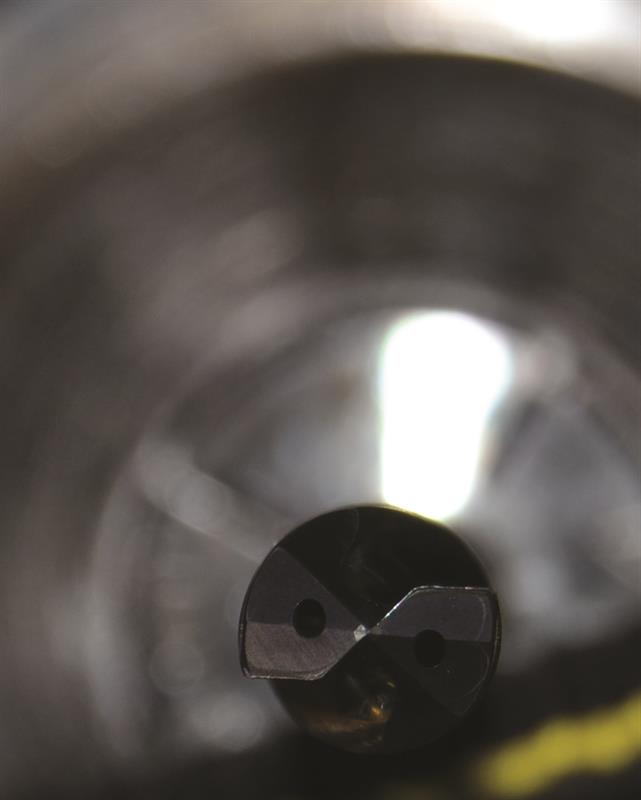The traditional 'twist drill' has been around for more than 150 years and its overall design has changed very little. The result of an innovative invention back in 1863 from American mechanic Stephen Morse from Massachusetts, USA, there has, however, always been the ambition to improve on the original design. And, yes, it was Morse that gave his name to the taper, which he developed to hold and drive such drills.
So while, today, the style and general use of a standard twist drill remains very close to its original roots, there is a constant need to push the boundaries and find new ways to enhance performance, extend tool life and reduce overall costs.
Dormer Pramet's (0870 850 4466) Continuously Thinned Web (CTW) geometry is just such a development. Patented in 2001, CTW is unique to the company's rotary drilling range. The technology supports more effective drilling, prolonging the life of the cutting tool and aiding accurate regrinding that maintains performance over the long term.
CTW sees a web thinning feature integrated along the flute form, meaning that the thinning amount is already set and, therefore, that no adjustments are needed during regrinding, regardless of drill length.
Employed on previous designs, CTW is a key feature of the newly released R459 multi-material drill for applications up to 8xD, which is produced under the company's Dormer product brand.
Ricky Payling, Dormer Pramet's application specialist for rotary tools, explains the benefits that the technology confers on the actual drilling process: "CTW increases both flute volume and cross sectional strength. The combination of these elements ensures consistent forces throughout the drilling cycle, with little or no increase in power requirement as the drill penetrates deeper into the hole. This, in turn, allows increased cutting speeds and greater performance reliability, without compromising tool life."
And as thrust forces are kept consistently low, the result is less wear and tear on the machine tool, providing further benefit to the end-user, the company adds.
Moreover, CTW makes it easier to regrind the new drill, offering more consistent long-term performance. Following regrinding, this design feature ensures the drill is restored to as close to its original properties as possible, offering a cost-effective solution in a simplified manner, explains Dormer Pramet.
 CTW sees a web thinning feature integrated along the drill's flute
CTW sees a web thinning feature integrated along the drill's flute
ADDITIONAL OPERATION
Traditionally after point grinding, web thinning is performed as an additional operation. This sees the length of the chisel edge reduced, in order to reduce the thrust force required when drilling. CTW technology simplifies the chisel thinning process, as the thinning feature is integrated along the flute form, making its achievement simultaneous with drill regrinding.
Incorporating CTW into a drill not only enables the complexities of the regrinding operation to be reduced but, because the web thinning depth is built into the design, the symmetry of the tool is retained after regrind. This means drill performance will not degenerate over time, with torque strength maintained after repeated regrinds. The drill is effectively thinned throughout the life of the tool, avoiding the costs and difficulties associated with this additional operation to the user.
Payling amplifies this benefit: "Generally, a drill after regrind will be at around 75-80% of its original qualities and performance, but with CTW included this increases significantly, to 90-95%.
"Also, a regrind company working with a batch of drills with CTW included will significantly reduce its lead time, compared with those that do not. This offers a quick turn-around for customers, simplified logistics, while machine downtime is kept to a minimum."
CTW is unique to Dormer Pramet and the cutting tool company hopes to expand its use to other drilling ranges in the near future.
BENEFITS PROVEN
Turning to the performance of the R459 in particular, its versatility in machining a variety of materials is its strength, with recent in-house testing using the new drill on aluminium, hardened steel and stainless steel showcasing how CTW is beneficial in differing applications and conditions.
During a test in stainless steel 316L using cutting data of Vc 35 m/min at a feed of 0.1 mm/rev (1,395 rpm at 140 mm/min), the R459 ran for 30 minutes contact time and showed a small amount of pick up, with an even wear scar across the cutting edges evident.
Similarly, when machining aluminium, the drill was run at Dormer catalogue data of Vc 285 m/min (11,340 rpm) and a feed of 0.26 mm/rev (2,950 mm/min). After 30 minutes of contact time, the drill showed minimal wear across cutting edges, with a small amount of pick-up.
In the development of the R459 with CTW, Dormer Pramet undertook a range of competitor testing, during which the drill performed well against five others.
To ensure fairness against the competition, all the drills were tested in the same conditions. For machining hardened steel (AMG 1.5), hole depth was set at 40 mm, surface speed was 80 m/min at 5,092 rpm, with feed set at 0.09 mm/rev (458 mm/min).
Among those tested, only Dormer's drill and one other competitor lasted the full 30 minutes, drilling more than 340 holes without any problems.
In the same test, another lasted half an hour but offered a poor finish and noisy performance, while another lasted the time but only at 7xD capability. The remaining two failed inside 20 minutes.
From the initial test, the best performing competitor was then selected for tool life comparison, using the same conditions. The R459 lasted for a total of 80 minutes, drilling 900 holes without any problems, while the competitor was badly worn after completing the same operation.
The tests showcased that even with the CTW web-thinning feature, deep-hole drills can perform successfully in a range of material applications. This consistent performance, enhanced tool life, improved regrind process and, ultimately, a reduction in costs offers a win-win solution for all, says Dormer Pramet.
This article was originally published in the July 2015 issue of Machinery.




